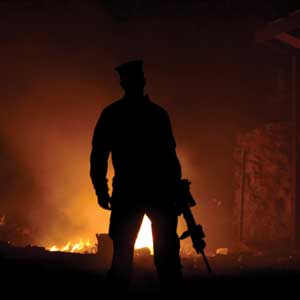
With the 116th Congress underway, DAV is initiating a new legislative campaign to ensure that all veterans who served near active burn pits in Afghanistan, Iraq and other locations receive health care and compensation benefits from the Department of Veterans Affairs for conditions and illnesses related to those toxic exposures.
Burn pits have been used for decades to dispose of waste and garbage generated on American military bases overseas, primarily in Iraq and Afghanistan. There were more than 250 burn pits in Afghanistan and Iraq that released an array of pollutants into the air, including particulate matter and known carcinogens.
Within months or years after returning from deployment, some veterans exposed to the toxins emitted by burn pits, and who had no other known risk factors, reported rare pulmonary issues, insomnia and cancers. However, the VA does not currently provide a presumption of service connection for any diseases related to burn pit exposure, though many experts believe that ongoing and future research could establish such links.
In 2010, lawmakers banned the military from using burn pits except where there was no feasible alternative. In 2013, Congress mandated the creation of the VA’s Airborne Hazards and Open Burn Pit Registry, and the 2018 defense-spending bill required the VA to coordinate further research on the effects of burn pits. DAV, who brought the hazards of burn pits to light as far back as 2007, has made further research into these exposures a legislative priority for the 116th Congress.
“We know from the experience of Vietnam War veterans exposed to Agent Orange that it can be years before the effects begin to manifest and decades before there is scientific consensus linking exposure to specific health conditions and illnesses,” said National Legislative Director Joy Ilem.
Burn pits were known to have been used during the first Persian Gulf War and in Djibouti after Sept. 11, 2001, according to the Department of Defense. However, there remains a misconception that burn pit exposure only impacts post-9/11 veterans.
“Congress needs to ensure veterans from all eras and conflicts who served in areas where burn pits were present are included in any legislation related to these toxic exposures,” said Ilem.
In addition to advocating for more research, DAV is also working to enact legislation to define exactly when and where veterans were exposed to burn-pit-related toxins, making it easier to establish service connection today and presumptive diseases in the future.
“By passing legislation to concede that veterans who served near burn pits were exposed to specific known toxins, Congress can remove obstacles for individual veterans seeking disability compensation and other benefits due to direct service connection,” said Ilem. “While a concession of burn pit exposure will not establish presumptive service connection for any diseases and illnesses today, it is an important step that will prepare the VA to take action in the future, if and when medical evidence establishes the necessary links.”





